Law and Society: A Cross-Cultural Analysis of Assault and Battery Laws
VerifiedAdded on 2023/04/21
|6
|2307
|201
Essay
AI Summary
This essay examines the legal definitions and societal implications of assault and battery across five distinct regions: Australia, Italy, Iran, Cuba, and Northern Cheyenne. It explores how each jurisdiction addresses these offenses, considering factors such as cultural norms, legal traditions, and the severity of penalties. In Australia, the focus is on compensation and the degree of harm caused. Italian law categorizes assault as a misdemeanor with lighter penalties unless significant bodily harm occurs. Iran, under Islamic law, treats assault as a Tazir crime subject to judicial discretion. Cuba distinguishes between assault and attempted felony, with stricter penalties for weapon involvement. Finally, the Northern Cheyenne tribe views physical altercations within a ceremonial context, resolving disputes through fist fights. The essay concludes by assessing the fairness and societal acceptance of each approach, highlighting the diverse ways in which law and society intersect in addressing assault and battery. Desklib offers more resources for students.
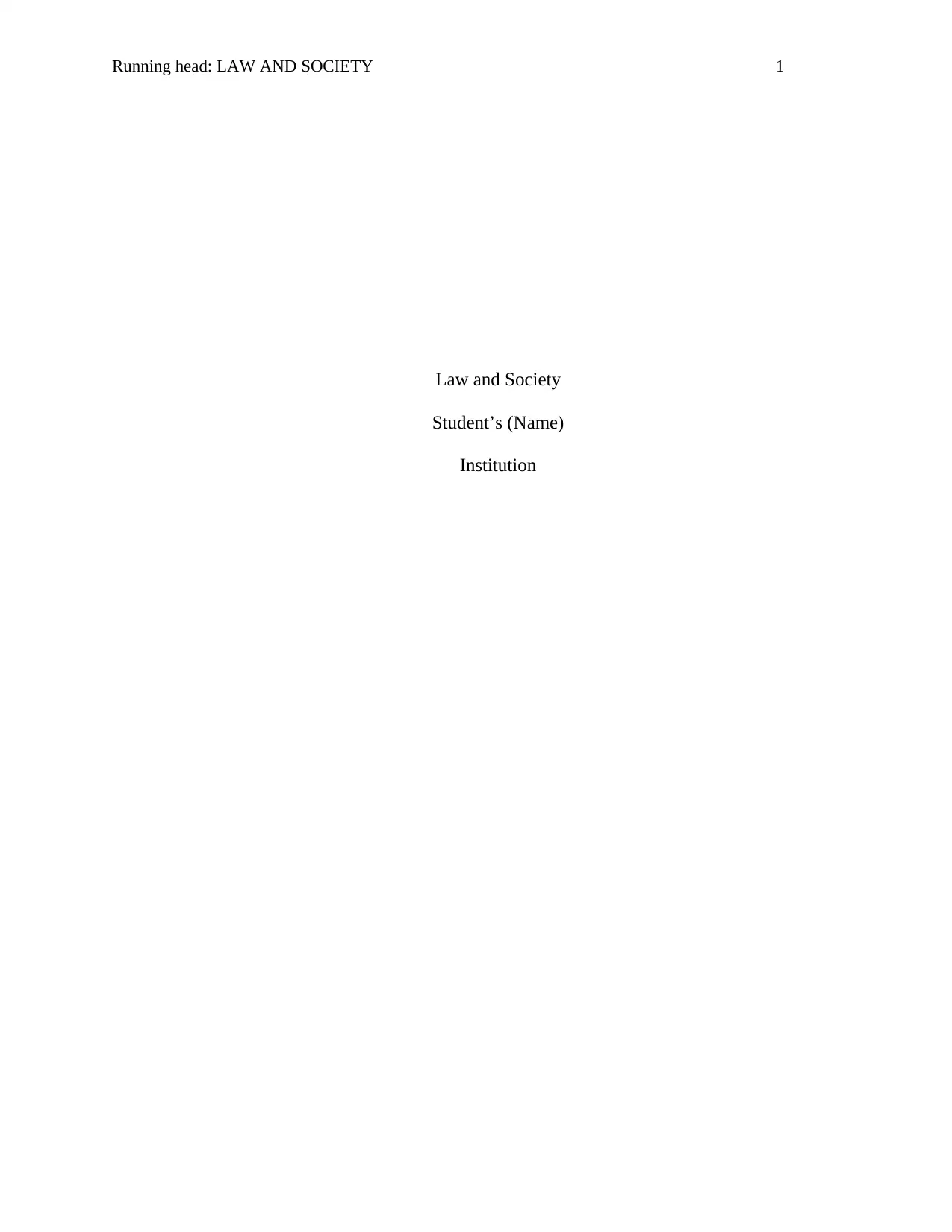
Running head: LAW AND SOCIETY 1
Law and Society
Student’s (Name)
Institution
Law and Society
Student’s (Name)
Institution
Secure Best Marks with AI Grader
Need help grading? Try our AI Grader for instant feedback on your assignments.
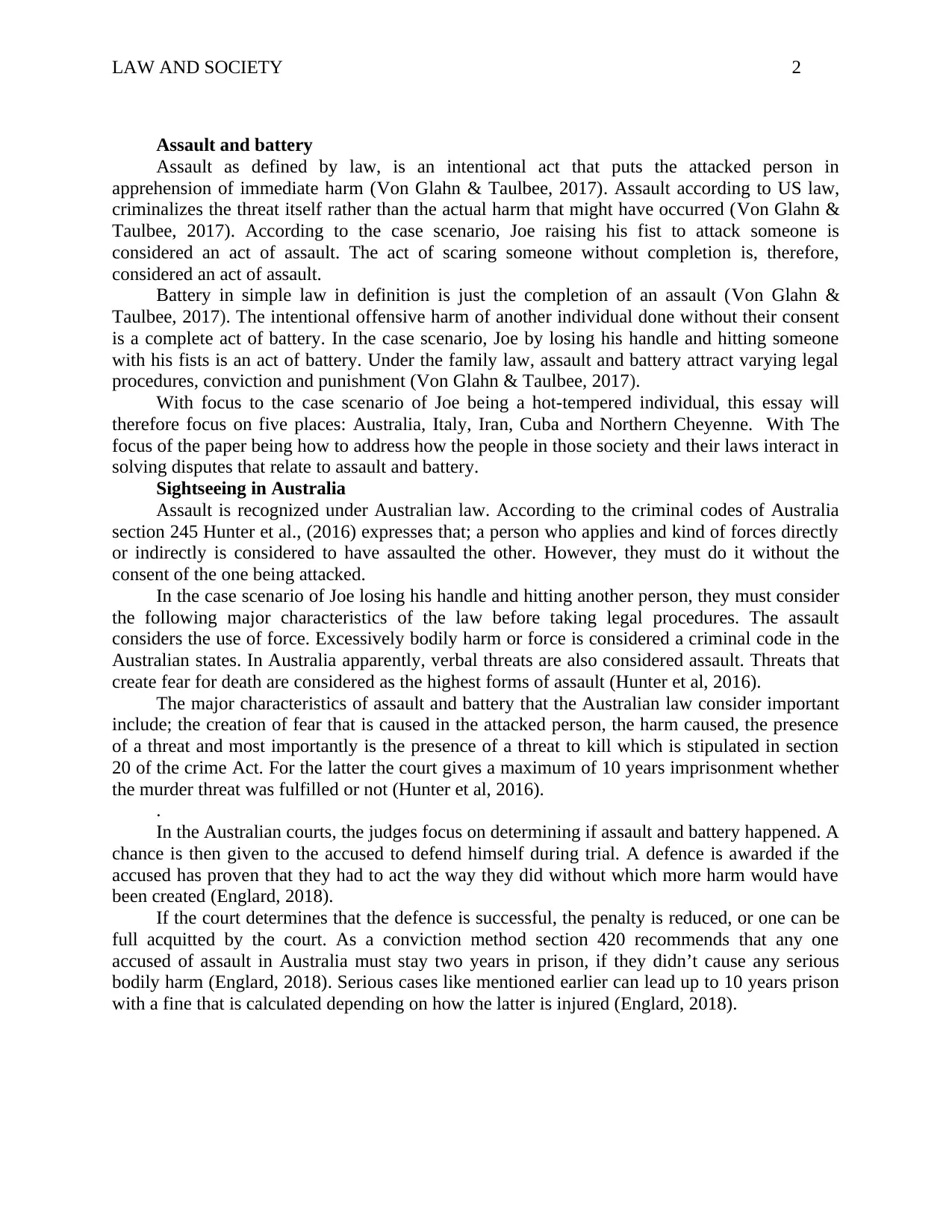
LAW AND SOCIETY 2
Assault and battery
Assault as defined by law, is an intentional act that puts the attacked person in
apprehension of immediate harm (Von Glahn & Taulbee, 2017). Assault according to US law,
criminalizes the threat itself rather than the actual harm that might have occurred (Von Glahn &
Taulbee, 2017). According to the case scenario, Joe raising his fist to attack someone is
considered an act of assault. The act of scaring someone without completion is, therefore,
considered an act of assault.
Battery in simple law in definition is just the completion of an assault (Von Glahn &
Taulbee, 2017). The intentional offensive harm of another individual done without their consent
is a complete act of battery. In the case scenario, Joe by losing his handle and hitting someone
with his fists is an act of battery. Under the family law, assault and battery attract varying legal
procedures, conviction and punishment (Von Glahn & Taulbee, 2017).
With focus to the case scenario of Joe being a hot-tempered individual, this essay will
therefore focus on five places: Australia, Italy, Iran, Cuba and Northern Cheyenne. With The
focus of the paper being how to address how the people in those society and their laws interact in
solving disputes that relate to assault and battery.
Sightseeing in Australia
Assault is recognized under Australian law. According to the criminal codes of Australia
section 245 Hunter et al., (2016) expresses that; a person who applies and kind of forces directly
or indirectly is considered to have assaulted the other. However, they must do it without the
consent of the one being attacked.
In the case scenario of Joe losing his handle and hitting another person, they must consider
the following major characteristics of the law before taking legal procedures. The assault
considers the use of force. Excessively bodily harm or force is considered a criminal code in the
Australian states. In Australia apparently, verbal threats are also considered assault. Threats that
create fear for death are considered as the highest forms of assault (Hunter et al, 2016).
The major characteristics of assault and battery that the Australian law consider important
include; the creation of fear that is caused in the attacked person, the harm caused, the presence
of a threat and most importantly is the presence of a threat to kill which is stipulated in section
20 of the crime Act. For the latter the court gives a maximum of 10 years imprisonment whether
the murder threat was fulfilled or not (Hunter et al, 2016).
.
In the Australian courts, the judges focus on determining if assault and battery happened. A
chance is then given to the accused to defend himself during trial. A defence is awarded if the
accused has proven that they had to act the way they did without which more harm would have
been created (Englard, 2018).
If the court determines that the defence is successful, the penalty is reduced, or one can be
full acquitted by the court. As a conviction method section 420 recommends that any one
accused of assault in Australia must stay two years in prison, if they didn’t cause any serious
bodily harm (Englard, 2018). Serious cases like mentioned earlier can lead up to 10 years prison
with a fine that is calculated depending on how the latter is injured (Englard, 2018).
Assault and battery
Assault as defined by law, is an intentional act that puts the attacked person in
apprehension of immediate harm (Von Glahn & Taulbee, 2017). Assault according to US law,
criminalizes the threat itself rather than the actual harm that might have occurred (Von Glahn &
Taulbee, 2017). According to the case scenario, Joe raising his fist to attack someone is
considered an act of assault. The act of scaring someone without completion is, therefore,
considered an act of assault.
Battery in simple law in definition is just the completion of an assault (Von Glahn &
Taulbee, 2017). The intentional offensive harm of another individual done without their consent
is a complete act of battery. In the case scenario, Joe by losing his handle and hitting someone
with his fists is an act of battery. Under the family law, assault and battery attract varying legal
procedures, conviction and punishment (Von Glahn & Taulbee, 2017).
With focus to the case scenario of Joe being a hot-tempered individual, this essay will
therefore focus on five places: Australia, Italy, Iran, Cuba and Northern Cheyenne. With The
focus of the paper being how to address how the people in those society and their laws interact in
solving disputes that relate to assault and battery.
Sightseeing in Australia
Assault is recognized under Australian law. According to the criminal codes of Australia
section 245 Hunter et al., (2016) expresses that; a person who applies and kind of forces directly
or indirectly is considered to have assaulted the other. However, they must do it without the
consent of the one being attacked.
In the case scenario of Joe losing his handle and hitting another person, they must consider
the following major characteristics of the law before taking legal procedures. The assault
considers the use of force. Excessively bodily harm or force is considered a criminal code in the
Australian states. In Australia apparently, verbal threats are also considered assault. Threats that
create fear for death are considered as the highest forms of assault (Hunter et al, 2016).
The major characteristics of assault and battery that the Australian law consider important
include; the creation of fear that is caused in the attacked person, the harm caused, the presence
of a threat and most importantly is the presence of a threat to kill which is stipulated in section
20 of the crime Act. For the latter the court gives a maximum of 10 years imprisonment whether
the murder threat was fulfilled or not (Hunter et al, 2016).
.
In the Australian courts, the judges focus on determining if assault and battery happened. A
chance is then given to the accused to defend himself during trial. A defence is awarded if the
accused has proven that they had to act the way they did without which more harm would have
been created (Englard, 2018).
If the court determines that the defence is successful, the penalty is reduced, or one can be
full acquitted by the court. As a conviction method section 420 recommends that any one
accused of assault in Australia must stay two years in prison, if they didn’t cause any serious
bodily harm (Englard, 2018). Serious cases like mentioned earlier can lead up to 10 years prison
with a fine that is calculated depending on how the latter is injured (Englard, 2018).
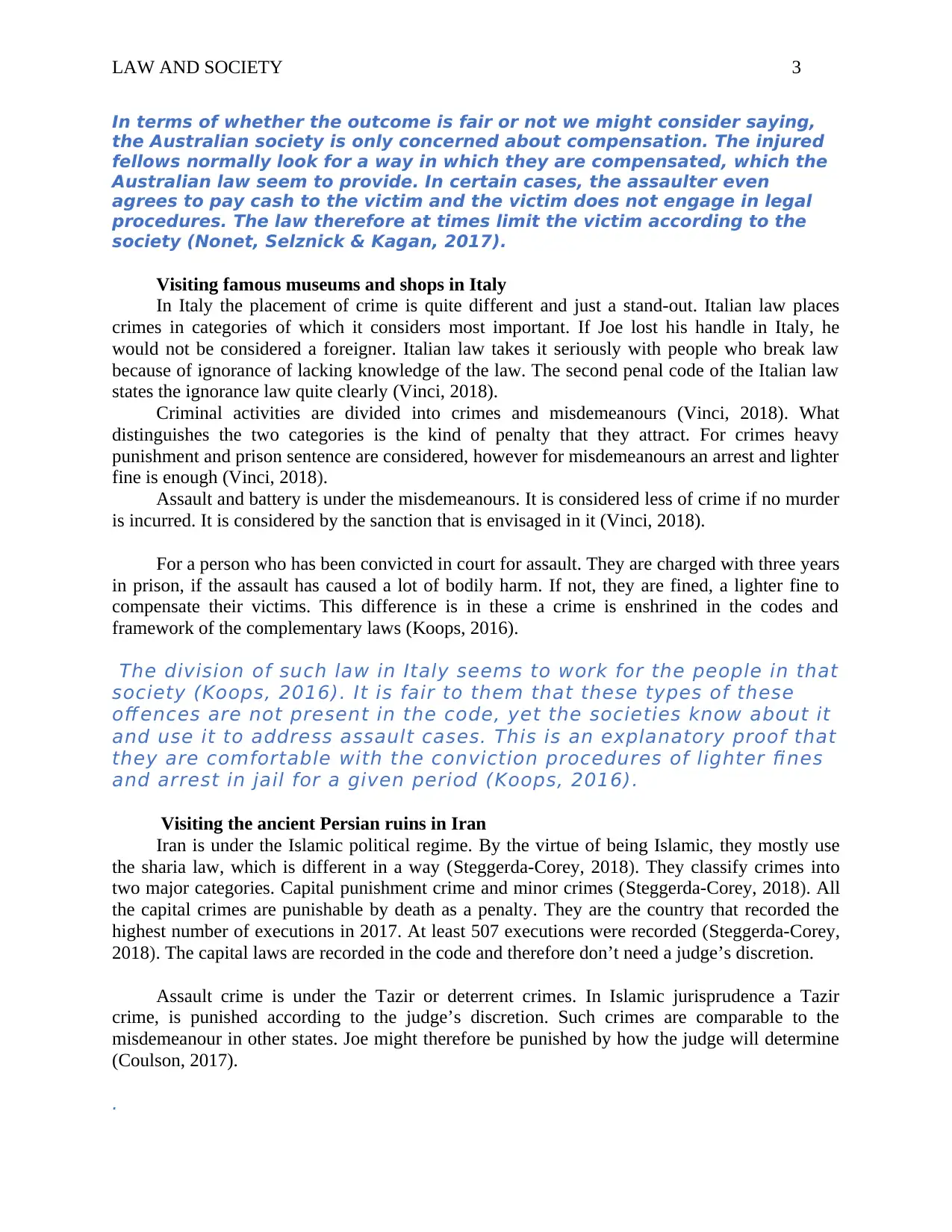
LAW AND SOCIETY 3
In terms of whether the outcome is fair or not we might consider saying,
the Australian society is only concerned about compensation. The injured
fellows normally look for a way in which they are compensated, which the
Australian law seem to provide. In certain cases, the assaulter even
agrees to pay cash to the victim and the victim does not engage in legal
procedures. The law therefore at times limit the victim according to the
society (Nonet, Selznick & Kagan, 2017).
Visiting famous museums and shops in Italy
In Italy the placement of crime is quite different and just a stand-out. Italian law places
crimes in categories of which it considers most important. If Joe lost his handle in Italy, he
would not be considered a foreigner. Italian law takes it seriously with people who break law
because of ignorance of lacking knowledge of the law. The second penal code of the Italian law
states the ignorance law quite clearly (Vinci, 2018).
Criminal activities are divided into crimes and misdemeanours (Vinci, 2018). What
distinguishes the two categories is the kind of penalty that they attract. For crimes heavy
punishment and prison sentence are considered, however for misdemeanours an arrest and lighter
fine is enough (Vinci, 2018).
Assault and battery is under the misdemeanours. It is considered less of crime if no murder
is incurred. It is considered by the sanction that is envisaged in it (Vinci, 2018).
For a person who has been convicted in court for assault. They are charged with three years
in prison, if the assault has caused a lot of bodily harm. If not, they are fined, a lighter fine to
compensate their victims. This difference is in these a crime is enshrined in the codes and
framework of the complementary laws (Koops, 2016).
The division of such law in Italy seems to work for the people in that
society (Koops, 2016). It is fair to them that these types of these
off ences are not present in the code, yet the societies know about it
and use it to address assault cases. This is an explanatory proof that
they are comfortable with the conviction procedures of lighter fi nes
and arrest in jail for a given period (Koops, 2016).
Visiting the ancient Persian ruins in Iran
Iran is under the Islamic political regime. By the virtue of being Islamic, they mostly use
the sharia law, which is different in a way (Steggerda-Corey, 2018). They classify crimes into
two major categories. Capital punishment crime and minor crimes (Steggerda-Corey, 2018). All
the capital crimes are punishable by death as a penalty. They are the country that recorded the
highest number of executions in 2017. At least 507 executions were recorded (Steggerda-Corey,
2018). The capital laws are recorded in the code and therefore don’t need a judge’s discretion.
Assault crime is under the Tazir or deterrent crimes. In Islamic jurisprudence a Tazir
crime, is punished according to the judge’s discretion. Such crimes are comparable to the
misdemeanour in other states. Joe might therefore be punished by how the judge will determine
(Coulson, 2017).
.
In terms of whether the outcome is fair or not we might consider saying,
the Australian society is only concerned about compensation. The injured
fellows normally look for a way in which they are compensated, which the
Australian law seem to provide. In certain cases, the assaulter even
agrees to pay cash to the victim and the victim does not engage in legal
procedures. The law therefore at times limit the victim according to the
society (Nonet, Selznick & Kagan, 2017).
Visiting famous museums and shops in Italy
In Italy the placement of crime is quite different and just a stand-out. Italian law places
crimes in categories of which it considers most important. If Joe lost his handle in Italy, he
would not be considered a foreigner. Italian law takes it seriously with people who break law
because of ignorance of lacking knowledge of the law. The second penal code of the Italian law
states the ignorance law quite clearly (Vinci, 2018).
Criminal activities are divided into crimes and misdemeanours (Vinci, 2018). What
distinguishes the two categories is the kind of penalty that they attract. For crimes heavy
punishment and prison sentence are considered, however for misdemeanours an arrest and lighter
fine is enough (Vinci, 2018).
Assault and battery is under the misdemeanours. It is considered less of crime if no murder
is incurred. It is considered by the sanction that is envisaged in it (Vinci, 2018).
For a person who has been convicted in court for assault. They are charged with three years
in prison, if the assault has caused a lot of bodily harm. If not, they are fined, a lighter fine to
compensate their victims. This difference is in these a crime is enshrined in the codes and
framework of the complementary laws (Koops, 2016).
The division of such law in Italy seems to work for the people in that
society (Koops, 2016). It is fair to them that these types of these
off ences are not present in the code, yet the societies know about it
and use it to address assault cases. This is an explanatory proof that
they are comfortable with the conviction procedures of lighter fi nes
and arrest in jail for a given period (Koops, 2016).
Visiting the ancient Persian ruins in Iran
Iran is under the Islamic political regime. By the virtue of being Islamic, they mostly use
the sharia law, which is different in a way (Steggerda-Corey, 2018). They classify crimes into
two major categories. Capital punishment crime and minor crimes (Steggerda-Corey, 2018). All
the capital crimes are punishable by death as a penalty. They are the country that recorded the
highest number of executions in 2017. At least 507 executions were recorded (Steggerda-Corey,
2018). The capital laws are recorded in the code and therefore don’t need a judge’s discretion.
Assault crime is under the Tazir or deterrent crimes. In Islamic jurisprudence a Tazir
crime, is punished according to the judge’s discretion. Such crimes are comparable to the
misdemeanour in other states. Joe might therefore be punished by how the judge will determine
(Coulson, 2017).
.
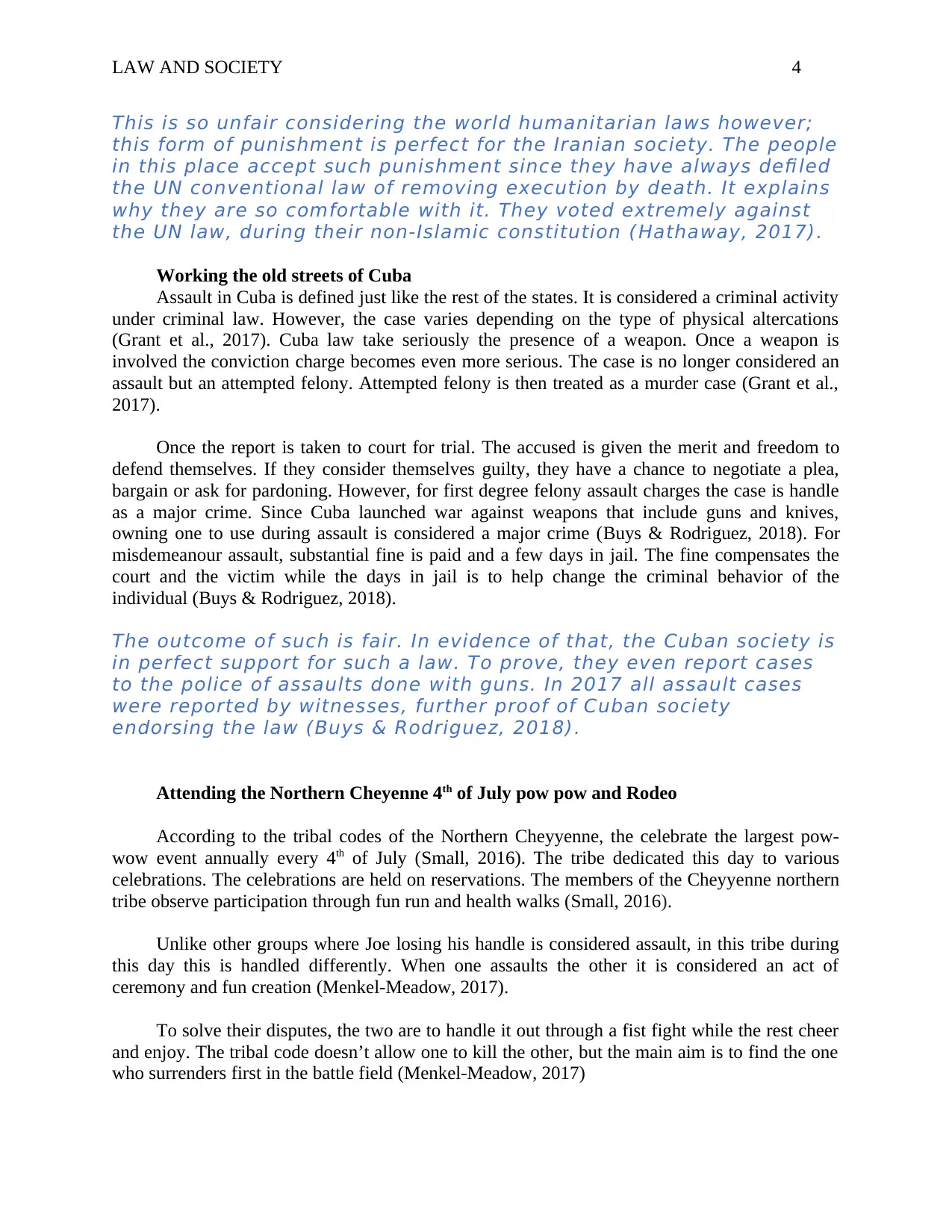
LAW AND SOCIETY 4
This is so unfair considering the world humanitarian laws however;
this form of punishment is perfect for the Iranian society. The people
in this place accept such punishment since they have always defi led
the UN conventional law of removing execution by death. It explains
why they are so comfortable with it. They voted extremely against
the UN law, during their non-Islamic constitution ( Hathaway, 2017).
Working the old streets of Cuba
Assault in Cuba is defined just like the rest of the states. It is considered a criminal activity
under criminal law. However, the case varies depending on the type of physical altercations
(Grant et al., 2017). Cuba law take seriously the presence of a weapon. Once a weapon is
involved the conviction charge becomes even more serious. The case is no longer considered an
assault but an attempted felony. Attempted felony is then treated as a murder case (Grant et al.,
2017).
Once the report is taken to court for trial. The accused is given the merit and freedom to
defend themselves. If they consider themselves guilty, they have a chance to negotiate a plea,
bargain or ask for pardoning. However, for first degree felony assault charges the case is handle
as a major crime. Since Cuba launched war against weapons that include guns and knives,
owning one to use during assault is considered a major crime (Buys & Rodriguez, 2018). For
misdemeanour assault, substantial fine is paid and a few days in jail. The fine compensates the
court and the victim while the days in jail is to help change the criminal behavior of the
individual (Buys & Rodriguez, 2018).
The outcome of such is fair. In evidence of that, the Cuban society is
in perfect support for such a law. To prove, they even report cases
to the police of assaults done with guns. In 2017 all assault cases
were reported by witnesses, further proof of Cuban society
endorsing the law (Buys & Rodriguez, 2018).
Attending the Northern Cheyenne 4th of July pow pow and Rodeo
According to the tribal codes of the Northern Cheyyenne, the celebrate the largest pow-
wow event annually every 4th of July (Small, 2016). The tribe dedicated this day to various
celebrations. The celebrations are held on reservations. The members of the Cheyyenne northern
tribe observe participation through fun run and health walks (Small, 2016).
Unlike other groups where Joe losing his handle is considered assault, in this tribe during
this day this is handled differently. When one assaults the other it is considered an act of
ceremony and fun creation (Menkel-Meadow, 2017).
To solve their disputes, the two are to handle it out through a fist fight while the rest cheer
and enjoy. The tribal code doesn’t allow one to kill the other, but the main aim is to find the one
who surrenders first in the battle field (Menkel-Meadow, 2017)
This is so unfair considering the world humanitarian laws however;
this form of punishment is perfect for the Iranian society. The people
in this place accept such punishment since they have always defi led
the UN conventional law of removing execution by death. It explains
why they are so comfortable with it. They voted extremely against
the UN law, during their non-Islamic constitution ( Hathaway, 2017).
Working the old streets of Cuba
Assault in Cuba is defined just like the rest of the states. It is considered a criminal activity
under criminal law. However, the case varies depending on the type of physical altercations
(Grant et al., 2017). Cuba law take seriously the presence of a weapon. Once a weapon is
involved the conviction charge becomes even more serious. The case is no longer considered an
assault but an attempted felony. Attempted felony is then treated as a murder case (Grant et al.,
2017).
Once the report is taken to court for trial. The accused is given the merit and freedom to
defend themselves. If they consider themselves guilty, they have a chance to negotiate a plea,
bargain or ask for pardoning. However, for first degree felony assault charges the case is handle
as a major crime. Since Cuba launched war against weapons that include guns and knives,
owning one to use during assault is considered a major crime (Buys & Rodriguez, 2018). For
misdemeanour assault, substantial fine is paid and a few days in jail. The fine compensates the
court and the victim while the days in jail is to help change the criminal behavior of the
individual (Buys & Rodriguez, 2018).
The outcome of such is fair. In evidence of that, the Cuban society is
in perfect support for such a law. To prove, they even report cases
to the police of assaults done with guns. In 2017 all assault cases
were reported by witnesses, further proof of Cuban society
endorsing the law (Buys & Rodriguez, 2018).
Attending the Northern Cheyenne 4th of July pow pow and Rodeo
According to the tribal codes of the Northern Cheyyenne, the celebrate the largest pow-
wow event annually every 4th of July (Small, 2016). The tribe dedicated this day to various
celebrations. The celebrations are held on reservations. The members of the Cheyyenne northern
tribe observe participation through fun run and health walks (Small, 2016).
Unlike other groups where Joe losing his handle is considered assault, in this tribe during
this day this is handled differently. When one assaults the other it is considered an act of
ceremony and fun creation (Menkel-Meadow, 2017).
To solve their disputes, the two are to handle it out through a fist fight while the rest cheer
and enjoy. The tribal code doesn’t allow one to kill the other, but the main aim is to find the one
who surrenders first in the battle field (Menkel-Meadow, 2017)
Secure Best Marks with AI Grader
Need help grading? Try our AI Grader for instant feedback on your assignments.
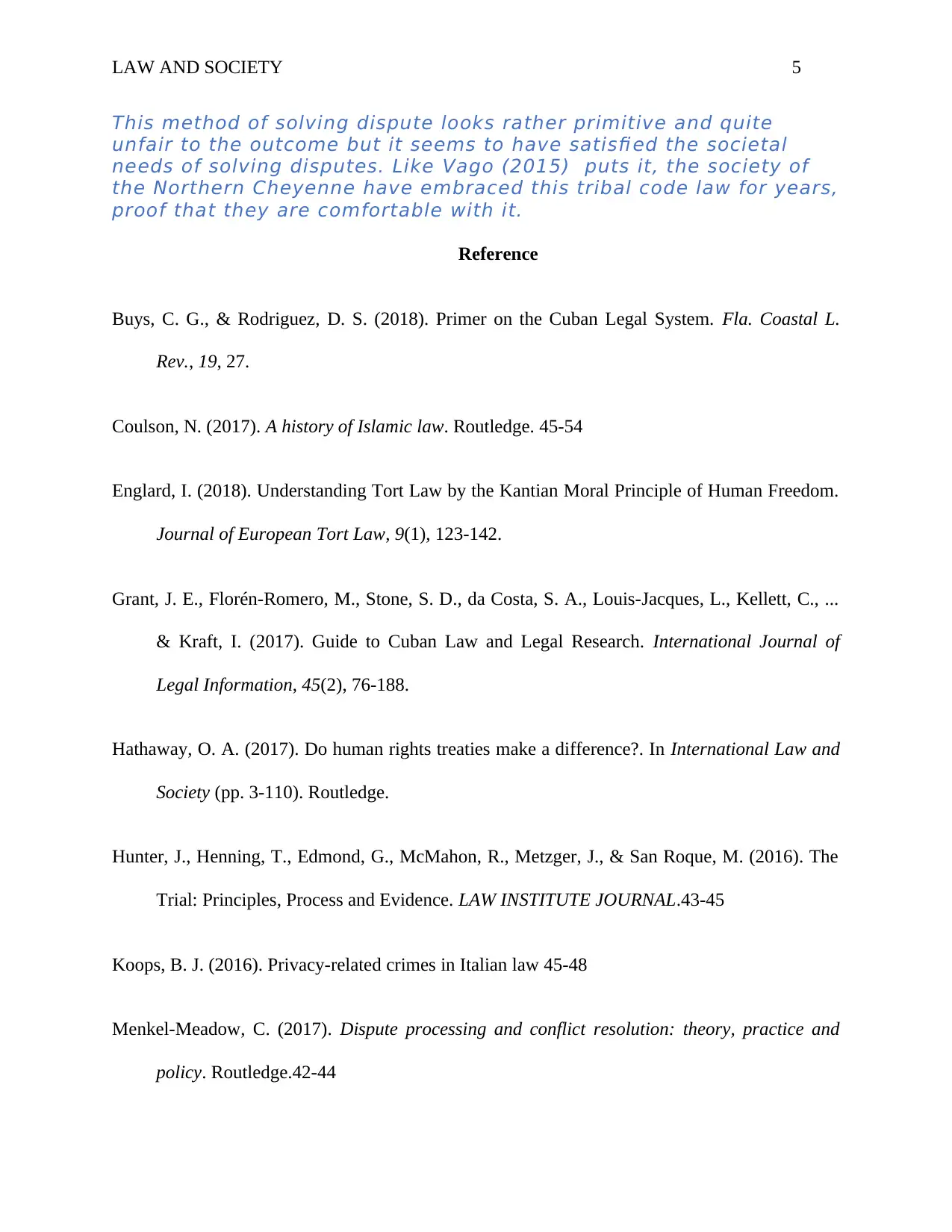
LAW AND SOCIETY 5
This method of solving dispute looks rather primitive and quite
unfair to the outcome but it seems to have satisfi ed the societal
needs of solving disputes. Like Vago (2015) puts it, the society of
the Northern Cheyenne have embraced this tribal code law for years,
proof that they are comfortable with it.
Reference
Buys, C. G., & Rodriguez, D. S. (2018). Primer on the Cuban Legal System. Fla. Coastal L.
Rev., 19, 27.
Coulson, N. (2017). A history of Islamic law. Routledge. 45-54
Englard, I. (2018). Understanding Tort Law by the Kantian Moral Principle of Human Freedom.
Journal of European Tort Law, 9(1), 123-142.
Grant, J. E., Florén-Romero, M., Stone, S. D., da Costa, S. A., Louis-Jacques, L., Kellett, C., ...
& Kraft, I. (2017). Guide to Cuban Law and Legal Research. International Journal of
Legal Information, 45(2), 76-188.
Hathaway, O. A. (2017). Do human rights treaties make a difference?. In International Law and
Society (pp. 3-110). Routledge.
Hunter, J., Henning, T., Edmond, G., McMahon, R., Metzger, J., & San Roque, M. (2016). The
Trial: Principles, Process and Evidence. LAW INSTITUTE JOURNAL.43-45
Koops, B. J. (2016). Privacy-related crimes in Italian law 45-48
Menkel-Meadow, C. (2017). Dispute processing and conflict resolution: theory, practice and
policy. Routledge.42-44
This method of solving dispute looks rather primitive and quite
unfair to the outcome but it seems to have satisfi ed the societal
needs of solving disputes. Like Vago (2015) puts it, the society of
the Northern Cheyenne have embraced this tribal code law for years,
proof that they are comfortable with it.
Reference
Buys, C. G., & Rodriguez, D. S. (2018). Primer on the Cuban Legal System. Fla. Coastal L.
Rev., 19, 27.
Coulson, N. (2017). A history of Islamic law. Routledge. 45-54
Englard, I. (2018). Understanding Tort Law by the Kantian Moral Principle of Human Freedom.
Journal of European Tort Law, 9(1), 123-142.
Grant, J. E., Florén-Romero, M., Stone, S. D., da Costa, S. A., Louis-Jacques, L., Kellett, C., ...
& Kraft, I. (2017). Guide to Cuban Law and Legal Research. International Journal of
Legal Information, 45(2), 76-188.
Hathaway, O. A. (2017). Do human rights treaties make a difference?. In International Law and
Society (pp. 3-110). Routledge.
Hunter, J., Henning, T., Edmond, G., McMahon, R., Metzger, J., & San Roque, M. (2016). The
Trial: Principles, Process and Evidence. LAW INSTITUTE JOURNAL.43-45
Koops, B. J. (2016). Privacy-related crimes in Italian law 45-48
Menkel-Meadow, C. (2017). Dispute processing and conflict resolution: theory, practice and
policy. Routledge.42-44
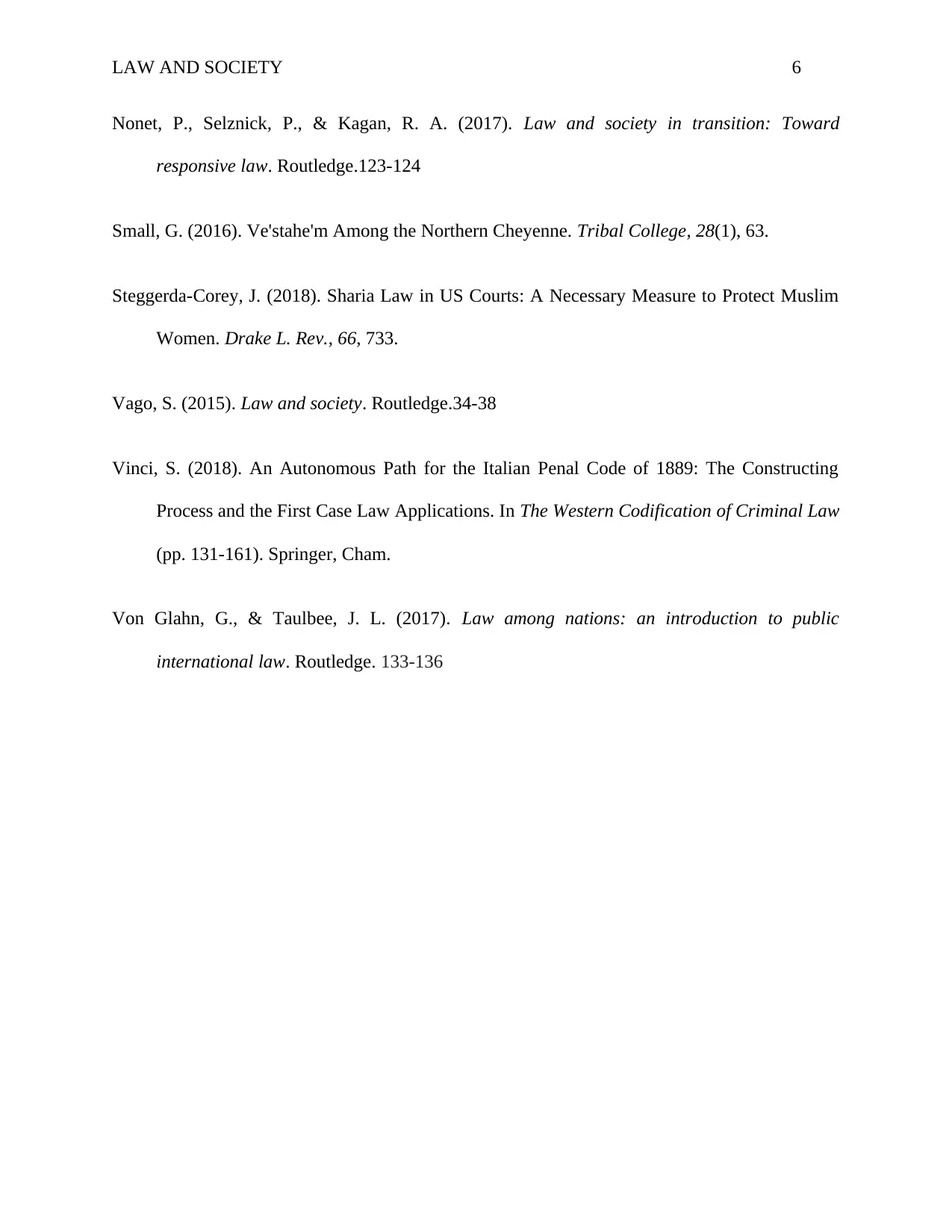
LAW AND SOCIETY 6
Nonet, P., Selznick, P., & Kagan, R. A. (2017). Law and society in transition: Toward
responsive law. Routledge.123-124
Small, G. (2016). Ve'stahe'm Among the Northern Cheyenne. Tribal College, 28(1), 63.
Steggerda-Corey, J. (2018). Sharia Law in US Courts: A Necessary Measure to Protect Muslim
Women. Drake L. Rev., 66, 733.
Vago, S. (2015). Law and society. Routledge.34-38
Vinci, S. (2018). An Autonomous Path for the Italian Penal Code of 1889: The Constructing
Process and the First Case Law Applications. In The Western Codification of Criminal Law
(pp. 131-161). Springer, Cham.
Von Glahn, G., & Taulbee, J. L. (2017). Law among nations: an introduction to public
international law. Routledge. 133-136
Nonet, P., Selznick, P., & Kagan, R. A. (2017). Law and society in transition: Toward
responsive law. Routledge.123-124
Small, G. (2016). Ve'stahe'm Among the Northern Cheyenne. Tribal College, 28(1), 63.
Steggerda-Corey, J. (2018). Sharia Law in US Courts: A Necessary Measure to Protect Muslim
Women. Drake L. Rev., 66, 733.
Vago, S. (2015). Law and society. Routledge.34-38
Vinci, S. (2018). An Autonomous Path for the Italian Penal Code of 1889: The Constructing
Process and the First Case Law Applications. In The Western Codification of Criminal Law
(pp. 131-161). Springer, Cham.
Von Glahn, G., & Taulbee, J. L. (2017). Law among nations: an introduction to public
international law. Routledge. 133-136
1 out of 6
Your All-in-One AI-Powered Toolkit for Academic Success.
+13062052269
info@desklib.com
Available 24*7 on WhatsApp / Email
![[object Object]](/_next/static/media/star-bottom.7253800d.svg)
Unlock your academic potential
© 2024 | Zucol Services PVT LTD | All rights reserved.

